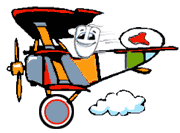|
Careers
for Freshers
Flying
 Flying
as a career has everything - glamour, travel and good money.
Besides, the idea of defying gravity and streaking across the
blue skies is definitely appealing. There is more to flying
than that. As a commercial pilot, you are responsible for the
billion-dollar aerodynamic machine and the numerous lives that
are entrusted in your hands. Flying
as a career has everything - glamour, travel and good money.
Besides, the idea of defying gravity and streaking across the
blue skies is definitely appealing. There is more to flying
than that. As a commercial pilot, you are responsible for the
billion-dollar aerodynamic machine and the numerous lives that
are entrusted in your hands.
•
Eligibility
A candidate must have completed their Intermediate in science
and acquire at least 50 %. You need to complete the requisite
number of hours, clear written papers and the medical examination.
You can also write to the DGCA, requesting them to send a form.
The address of DGCA is:
Director
of Airworthiness (CEO),
C/O Director General of Civil Aviation,
East Block III, R.K Puram
New Delhi-110 066.
•
Student's Pilot License :
The
first license you get is a Student's Pilot License or an SPL.
To be eligible for this license, you need to pass your SSC or
an examination equivalent to that, be at least 16 years of age
and have a medical certificate from an approved medical practitioner.
On clearing an oral exam based on air regulations, navigation,
meteorology, aircraft and engines conducted by the chief flying
instructor of a flying club, you will be given an SPL.
The
oral exam is elementary and based on facts about airplane signals,
specifications about the aircraft you intend to fly and directional
orientation. You cannot fly a solo in SPL.
•
Private Pilot's License :
To
acquire the Private Pilot's License or PPL you are required
to complete 40 hours of flying that includes 15 solo hours.
You also need to clear three papers - the Composite paper (a
combination of Navigation, Meteorology, Air Regulations), Aircraft
and Engines paper (Aerodynamics, theory of flight and engines)
and the Specific paper that is based on a particular aircraft.
•
Commercial Pilot's License
A Commercial
Pilot's License is what you get after completing 250 hours of
flying. It includes 150 hours of solo flying, 25 hours of cross-country
flying, 10 hours of instrument flying and 5 hours of solo night
flying. You need to clear six papers, namely Navigation, Meteorology,
Aircraft & Engines (technical paper), Specific (based on
a particular aircraft) and Air Regulations. Clearance at the
medical examination conducted by the Air force at their medical
centers in Dhaula Kuan, New Delhi and Institute of Aeronautical
Medicine (IAM), is also a must.
After
a CPL, you can build up on more flying hours, login 750 hours
of flight time, clear the requisite papers and acquire a Senior
Commercial Pilot's License (SCPL).
After
an SCPL, you can login 1500 hours of flight time and acquire
an All Transports Pilot's License or ATPL. The ATPL allows you
to fly any kind of aircraft and no doubt, is the most difficult
license to acquire. A pilot receives these licenses only after
approval of the DGCA.
•
Institutes
This
is what you should be looking for when choosing a flying club:
- How many aircraft does it have? How many of them are fit for
flying?
- What
are their charges per flying hour?
- Does the Chief Flying Instructor (CFI) enjoy a good reputation
- Are the students who have passed out of that flying club and
the ones who are flying there happy with it?
- How much
do you pay?
There
are numerous flying clubs that are government aided as well
as private. A government aided flying club is definitely cheaper,
charging about Rs 1,800-2,500 per hour.
In
a private flying club, the expenses with each flying hour cost
nearly Rs 3,500-4,000.
Amongst
private flying clubs, Ahmedabad Aviation Academy (AAA) in Ahmedabad
rules the roost.
Indira Gandhi Rashtriya Udaan Akademi, better known as IGRUA
is a government-aided flying academy and candidates are chosen
from all over India. The admissions are difficult and the prospective
candidate must have a PPL with 60 hours of flying apart from
clearing an entrance examination.
• The early years
Entry is at the level of a trainee pilot and after a year of
working under the supervision of an experienced pilot, the first
job is that of a co-pilot. Promotion to the post of captain
can come after eight years in service.
•
Prospects
You
can join a commercial airline as first officer or you could
join a big company such as TISCO, Kirloskar and Reliance and
fly their aircraft. .
If
you are doing your course at IGRUA, chances are, national airlines
like Air India, Indian Airlines and Pawan Hans will pick you
up from the campus.
•
Money
A trainee
pilot is taken on a monthly pay scale that ranges between Rs
2,500 to 3,500. In private aircraft, pilots draw anywhere between
Rs 15,000 to 20,000 a month.
 back
back
 top
top
|

 Flying
as a career has everything - glamour, travel and good money.
Besides, the idea of defying gravity and streaking across the
blue skies is definitely appealing. There is more to flying
than that. As a commercial pilot, you are responsible for the
billion-dollar aerodynamic machine and the numerous lives that
are entrusted in your hands.
Flying
as a career has everything - glamour, travel and good money.
Besides, the idea of defying gravity and streaking across the
blue skies is definitely appealing. There is more to flying
than that. As a commercial pilot, you are responsible for the
billion-dollar aerodynamic machine and the numerous lives that
are entrusted in your hands.